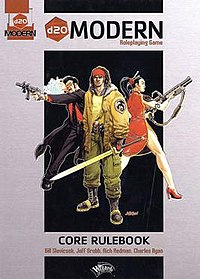d20-
I think that the "birth" of the d20 system stemmed from the original Dungeons & Dragons. Wizards of the Coast took the idea, added some fun extras like Feats and a large selection of Skills and made the basic system available for other publishers to utilize while keeping certain creative rights.
The d20 System is a derivative of the third edition D&D game system. The three primary designers behind the d20 System were Jonathan Tweet, Monte Cook and Skip Williams; many others contributed, most notably Richard Baker and Wizards of the Coast then-president Peter Adkison. Many give Tweet the bulk of the credit for the basic resolution mechanic, citing similarities to the system behind his game Ars Magica. Tweet, however, stated "The other designers already had a core mechanic similar to the current one when I joined the design team".
To resolve an action in the d20 System, a player rolls a 20-sided die and adds modifiers based on the natural aptitude of the character (defined by six abilities: Strength, Dexterity, Constitution, Intelligence, Wisdom, and Charisma) and how skilled the character is in various fields (such as in combat), as well as other, situational modifiers. If the result is greater than or equal to a target number (called a Difficulty Class or DC) then the action succeeds. This is called the Core Mechanic. This system is consistently used for all action resolution in the d20 System: in prior games in the D&D family, the rules for different actions, such as the first-edition hit tables or the second-edition AD&D "THAC0" and saving throw mechanics, varied considerably in which dice were used and even whether high numbers or low numbers were preferable.
The d20 System is not presented as a universal system in any of its publications or free distributions, unlike games like GURPS. Rather, the core system has been presented in a variety of formats that have been adapted by various publishers (both Wizards of the Coast and third-party) to specific settings and genres, much like the Basic Role-Playing system common to early games by veteran RPG publisher Chaosium.
The rules for the d20 System are defined in the System Reference Document or SRD (two separate SRDs were released, one for D&D edition 3.0 and one for edition 3.5), which may be copied freely or even sold. Designed for fantasy-genre games in (usually) a pseudo-medieval setting, the SRD is drawn from the Dungeons & Dragons books Player's Handbook v3.5, Expanded Psionics Handbook, Dungeon Master's Guide v3.5, Monster Manual v3.5, Deities and Demigods v3.0, Unearthed Arcana, and Epic Level Handbook. Information from these books not in the SRD include detailed descriptions, flavor-text, and material Wizards of the Coast considers Product Identity (such as references to the Greyhawk campaign setting and information on mind flayers).
d20 Modern has its own SRD, called the Modern System Reference Document (MSRD). The MSRD includes material from the d20 Modern roleplaying game, Urban Arcana Campaign Setting, the d20 Menace Manual, and d20 Future; this can cover a wide variety of genres, but is intended for a modern-day, or in the case of the last of these, a futuristic setting.
The wonderful thing about the d20 system is that it allowed so many smaller publishers to write material for it and it would fall under the Open Game License (OGL). This was a great idea and allowed small publishers to get some notice and recognition for their work.
Role playing and collecting comics since age 10, I'd like to share my experiences and insight of RPG's. I hope that my reader's will also feel free to contribute their thoughts and feelings alongside my own. I'd like to keep the pen-and-paper in roleplaying games. [Formerly known as RPG4EVR] A non-biased place where you can read reviews of graphic novels and trade paperbacks. I also give my opinions and reviews of pop culture and events. [Formerly known as Zanziber's Point of View]
Subscribe to:
Post Comments (Atom)
Claw City Clackamas Grand Opening - My Experience
Clackamas Town Center 12000 SE 82nd Ave Happy Valley, OR 97086 Earlier this year, my roommates and I visited the Claw City in Lincoln City ...

-
Back in the 90's, I was part of the LARP organization known as The Camarilla . We were all fans of Vampire: The Masquerade . Before that...
-
Since July 2013, I have been working to raise money for the American Cancer Society . My motives for this are well documented in the former ...
-
September 6-8, 2024 Oregon Convention Center Portland, Oregon 2024 marks the 9th year in a row where I have been honored to be able to cover...





No comments:
Post a Comment